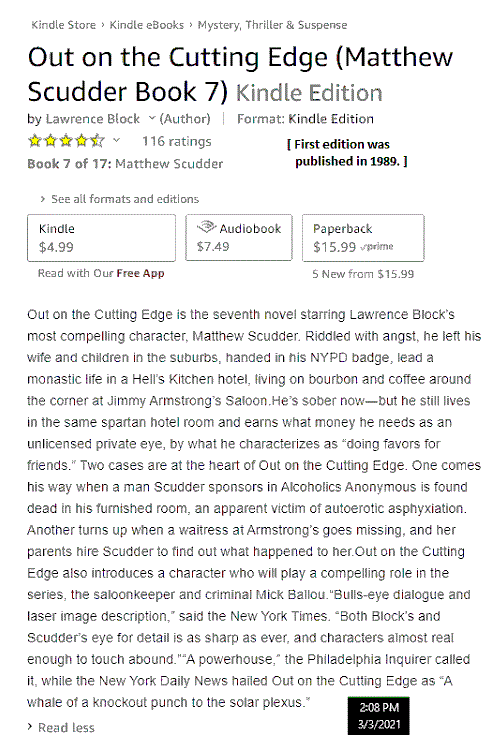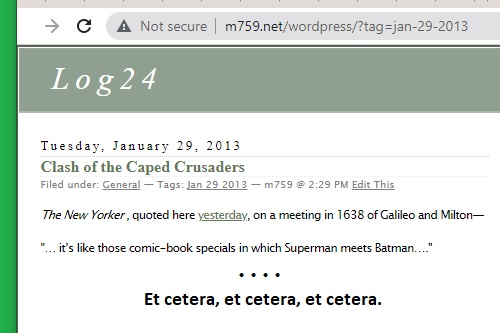
Saturday, December 23, 2023
Speed the Coulter: The Cutting Edge
Monday, March 6, 2023
The Cut Mudra
Thursday, January 19, 2023
Friday, November 5, 2021
The Author of In the Cut on Perception
From the Log24 post Literary Notes (March 10, 2015) —
|
We’ve talked before about how feeling different from the people around us – “mutant” was the word you used – informs or underpins the burgeoning writer’s mentality. Could you expand on that? By mutant, I mean that state in childhood and adolescence of isolation, sometimes blissful, often bewildering, when you realize that you have little in common with the people closest to you – not because you are superior in intelligence or sensitivity, but because you perceive the world in an utterly different way, which you assume to be a failing on your part. It was only through reading and discovering characters who shared that feeling that I realized when I was about 14 that I wasn’t insane. And yes, I think that the sensation, the awareness and then the conviction that your perception of the world is not what might be called conventional, is essential to the making of an artist. It is a little like speaking a different language from the people around you – it affords you solitude, but it also means that you are sometimes misunderstood.
— From an interview by Glen Duncan |
Wednesday, March 3, 2021
Out on the Cutting Edge*
| That edge, where artists are always transforming chaos into order, can be a very rough and dangerous place. Living there, an artist constantly risks falling fully into the chaos, instead of transforming it. But artists have always lived there, on the border of human understanding. Art bears the same relationship to society that the dream bears to mental life. You are very creative when you are dreaming. That is why, when you remember a dream, you think, “Where in the world did that come from?” It is very strange and incomprehensible that something can happen in your head, and you have no idea how it got there or what it means. It is a miracle: nature’s voice manifesting itself in your psyche. And it happens every night. Like art, the dream mediates between order and chaos. So, it is half chaos. That is why it is not comprehensible. It is a vision, not a fully fledged articulated production. Those who actualize those half-born visions into artistic productions are those who begin to transform what we do not understand into what we can at least start to see. That is the role of the artist, occupying the vanguard. That is their biological niche. They are the initial civilizing agents.
— Peterson, Jordan B., Beyond Order (p. 215), |
See also . . .
* Title credit —

Click for a clearer version —
Friday, November 5, 2021
The Which
The above title was suggested by the phrase "in which" . . .
Related material — An interview with author Susanna Moore from
the above date — January 29, 2013 — quoted here earlier today in …
The Author of In the Cut on Perception.

Susanna Moore
Adults may prefer Moore to the Christian witch
Madeleine L'Engle, another admirable writer.
The works of both Moore and L'Engle are much
better than damned fantasies of caped crusaders.
Thursday, October 1, 2020
Annals of Academia
New York magazine's "The Cut" —
BAD SCIENCE
JULY 14, 2016
Why It Took Social Science Years to Correct a Simple Error
About ‘Psychoticism’
By Jesse Singal
"What should we make of all of this? Partly, of course, this is
a story of conflicting personalities, of competitiveness between
researchers, of academics acting — let’s be frank — like dicks."
Or, worse, like New York Times reporter Benedict Carey —
|
A Theory About Conspiracy Theories
In a new study, psychologists tried to get a handle on the personality types that might be prone to outlandish beliefs.
By Benedict Carey, New York Times science reporter, . . . . The personality features that were solidly linked to conspiracy beliefs included some usual suspects: entitlement, self-centered impulsivity, cold-heartedness (the confident injustice collector), elevated levels of depressive moods and anxiousness (the moody figure, confined by age or circumstance). Another one emerged from the questionnaire that aimed to assess personality disorders — a pattern of thinking called “psychoticism.” Psychoticism is a core feature of so-called schizo-typal personality disorder, characterized in part by “odd beliefs and magical thinking” and “paranoid ideation.” In the language of psychiatry, it is a milder form of full-blown psychosis, the recurrent delusional state that characterizes schizophrenia. It’s a pattern of magical thinking that goes well beyond garden variety superstition and usually comes across socially as disjointed, uncanny or “off.”
In time, perhaps some scientist or therapist will try to slap a diagnosis on believers in Big Lie conspiracies that seem wildly out of line with reality. For now, Dr. Pennycook said, it is enough to know that, when distracted, people are far more likely to forward headlines and stories without vetting their sources much, if at all. |
Some elementary fact-checking reveals that historical definitions
of "psychoticism" vary greatly. Carey forwards this bullshit without
vetting his sources much, if at all.
Saturday, October 1, 2011
Like an Orb
It turns out that Fabrizio Palombi, author and editor of books on the late combinatorialist-philosopher Gian-Carlo Rota, is also an expert on the French charlatan Lacan. (For recent remarks related to Rota, see yesterday's Primordiality and the link "6.7 (June 7)" in today's The Crowe Sphere.)
"We all have our little mythologies."
— "Lacan’s Mathematics," by Amadou Guissé, Alexandre Leupin, and Steven D. Wallace (a preprint from the website of Steven D. Wallace, assistant professor of mathematics at Macon State College, Macon, GA.) A more extensive quote from "Lacan's Mathematics"—
Epistemological Cuts* or Births?
An epistemological cut can be described as the production of homonyms. For example, the word orb in Ptolemaic cosmology and the same word in the Kepler’s system, albeit similar, designate two entities that have nothing in common: the first one, in the Ancients’ cosmology, is a crystal sphere to which stars are attached; orb, for Kepler, is an ellipsis whose sole material existence is the algorithm describing its path. A cut becomes major when all word of different eras change meaning. A case in point is the cut between polytheism and monotheism (Judaism): the word god or god takes an entirely different meaning, and this change affects all areas of a vision of the world. From the non created world of the Ancients, inhabited by eternal Gods, we pass on to a world created by a unique God, who is outside of his creation. This cut affects all areas of thinking. However, mythology, albeit separated from the new vision by the cut, survives as an enduring residue. Our sexual thinking, for example, is essential mythological, as proven by the endurance of the Oedipus complex or our cult of this ancient deity called Eros. Love is inherently tied to what Freud called the omnipotence of thought or magical thinking.
Of course, the quintessential major epistemological cut for us is the break effectuated by modern science in the 17th century. All the names are affected by it: however, who can claim he or she has been entirely purged of pre-scientific reasoning? Despite us living in a scientific universe, we all have our little mythologies, residues of an era before the major epistemological cut.
Any modeling of major epistemological cuts, or paradigm changes as Thomas Kuhn would have it, has therefore to account at the same time for a complete break with past names (that is, new visions of the world) as well as the survival of old names and mythologies.
* For some background on this Marxist jargon, see Epistemological Break (La Coupure Épistémologique ) at the website Concept and Form: The Cahiers pour l’Analyse and Contemporary French Thought.
Sunday, April 18, 2010
Sermon for the Cruelest Month
In the Details
For kids– NY Times— "Hit-Girl survives."
For adults– LA Times—
"Dede Allen dies at 86; editor revolutionized
imagery, sound and pace in U.S. films
Her work on 1967's 'Bonnie and Clyde' ushered in
a new aesthetic that's now the standard in American film"
Claudia Luther of the LA Times on Allen, who died yesterday—
"… she learned the craft of editing: the assemblage of various scenes to create a coherent film.
In the early days of Hollywood, the cutters, as they were called, were often women, perhaps because, as Allen once commented to author Ally Acker, 'women have always been good at little details, like sewing.'"….
"Ebert wrote of Allen's work on 'The Hustler' that she found the rhythm in the pool games— 'the players circling, the cue sticks, the balls, the watching faces— that implies the trance-like rhythm of the players. Her editing "tells" the games so completely that if we don't understand pool, we forget that we don't.'"
____________________________________________
“Oscar is your name,” she said firmly.
“Oscar and Aster. Scar and Star.”

|
The Hustler |
|
Thursday, July 23, 2009
Thursday July 23, 2009
On Chris Hipp, who died of an apparent heart attack at 47 on July 14 (Bastille Day), 2009:
“‘He was the father of blade technology when he was with RLX,’ Jim Hall, president of the Blade System Alliance, said in an interview. ‘He invented the blade server.'”
“Hall said Hipp was a natural inventor who wanted to be on the cutting edge.”
— Jeffrey Burt at eWeek.com
Epitaph by a friend:
“He was known as a determined, fearsome and fair competitor.”
Hipp’s motto was “pounding idiots.”*
From a website celebrating the life and family (cf. previous two entries) of Leonard Shlain, author of Art & Physics and pioneering surgeon:
“Shlain n: unique last name of Russian origins. Possible meanings: 1: Sound sword makes as it’s pulled from sheath” —Shlain.com
A more authentic sound:
“The blade actually does sing. When it is withdrawn from the sheath it makes a ‘Tshuiiing’ sound as one hears in the movies. It rings like a bell.”

Steel Addiction, Custom Knives
A less authentic sound:

* The residents of Id (as in the above cartoon) are known, affectionately, as Idiots.
Tuesday, August 21, 2007
Tuesday August 21, 2007

Part I:
Overview of Unix
at pangea.stanford.edu
Last revision August 2, 2004
“The Unix operating environment is organized into three layers. The innermost level of Unix is the kernel. This is the actual operating system, a single large program that always resides in memory. Sections of the code in this program are executed on behalf of users to do needed tasks, like access files or terminals. Strictly speaking, the kernel is Unix.
The next level of the Unix environment is composed of programs, commands, and utilities. In Unix, the basic commands like copying or removing files are implemented not as part of the kernel, but as individual programs, no different really from any program you could write. What we think of as the commands and utilities of Unix are simply a set of programs that have become standardized and distributed. There are hundreds of these, plus many additional utilities in the public domain that can be installed.
The final level of the Unix environment, which stands like an umbrella over the others, is the shell. The shell processes your terminal input and starts up the programs that you request. It also allows you to manipulate the environment in which those programs will execute in a way that is transparent to the program. The program can be written to handle standard cases, and then made to handle unusual cases simply by manipulating its environment, without having to have a special version of the program.” (My italics.)
Part II:
Programs
From my paper journal
on the date
“Good Will Hunting”
was released:
|
Friday, December 5, 1997 To: The executive editor, The New York Times Re: The Front Page/His Girl Friday Match the speaker with the speech–
|
||||
| The Speaker | Frame of Reference | |||
| 1. | rosebud | A. | J. Paul Getty | The front page, N.Y. Times, Monday, 12/1/97 |
| 2. | clock | B. | Joel Silver | Page 126, The New Yorker, 3/21/94 |
| 3. | act | C. | Blanche DuBois | The Elysian Fields |
| 4. | waltz | D. | Bob Geldof | People Weekly 12/8/97 |
| 5. | temple | E. | St. Michael | Heaven’s Gate |
| 6. | watch | F. | Susanna Moore | In the Cut (pbk., Dec. ’96) p. 261 |
| 7. | line | G. | Joseph Lelyveld | Page A21, The New York Times, 12/1/97 |
| 8. | chair | H. | Kylie Minogue | Page 69, People Weekly, 12/8/97 |
| 9. | religion | I. | Carol Gilligan | The Garden of Good and Evil |
| 10. | wife | J. | John Travolta | “Michael,” the movie |
| 11. | harp | K. | Shylock | Page 40, N.Y. Review of Books, 12/4/97 |
| 12. | Oscar | L. | Stephen King | The Shining (pbk., 1997), pp. 316, 317 |
“…while the scientist sees
everything that happens
in one point of space,
the poet feels
everything that happens
in one point of time…
all forming an
instantaneous and transparent
organism of events….”
Part III:
The Bourne Shell
“The binary program of the Bourne shell or a compatible program is located at /bin/sh on most Unix systems, and is still the default shell for the root superuser on many current Unix implementations.” –Wikipedia
See also
the recent comments
of root@matrix.net in
Peter Woit’s weblog.
“Hey, Carrie-Anne,
what’s your game now….”
— The Hollies, 1967
Wednesday, November 19, 2003
Wednesday November 19, 2003
Staying the Course
“However flawed the case for invading Iraq may have been, the premature withdrawal of U.S. military forces would not only be a humiliating defeat for the United States but a betrayal of the hopes of the Iraqi people….”
— “Staying the Course,” editorial in America, the Jesuit weekly, Nov. 24, 2003
“…all means to prevent procreation are illicit. This includes temporary or permanent sterilization, chemicals (like birth control pills or foams), mechanical devices (like the condom or diaphragm) or premature withdrawal.”
— “The Wisdom of Humanae Vitae,” by Father Jay Scott Newman
“This is a perfect example of what my father calls ‘thinking with your dick.’ “
— Susanna Moore, author of In the Cut
Today’s birthday: Meg Ryan, star of the film version of In the Cut.
See also the previous entry.
Thursday, June 5, 2003
Thursday June 5, 2003
Regime Change
at the New York Times:
With Honors
Departing New York Times executive editor
Howell Raines:
"Remember, when a great story breaks out,
go like hell."
|
Returning |
Good Will's |
From the date "Good Will Hunting" was released:
|
Friday, December 5, 1997 "Philosophers ponder the idea of identity: what it is to give something a name on Monday and have it respond to that name on Friday." To: The executive editor, The New York Times Re: The Front Page/His Girl Friday Match the speaker with the speech — |
||||
| The Speaker | Frame of Reference | |||
| 1. | rosebud | A. | J. Paul Getty | The front page, N.Y. Times, Monday, 12/1/97 |
| 2. | clock | B. | Joel Silver | Page 126, The New Yorker, 3/21/94 |
| 3. | act | C. | Blanche DuBois | The Elysian Fields |
| 4. | waltz | D. | Bob Geldof | People Weekly 12/8/97 |
| 5. | temple | E. | St. Michael | Heaven's Gate |
| 6. | watch | F. | Susanna Moore | In the Cut (pbk., Dec. '96) p. 261 |
| 7. | line | G. | Joseph Lelyveld | Page A21, The New York Times, 12/1/97 |
| 8. | chair | H. | Kylie Minogue | Page 69, People Weekly, 12/8/97 |
| 9. | religion | I. | Carol Gilligan | The Garden of Good and Evil |
| 10. | wife | J. | John Travolta | "Michael," the movie |
| 11. | harp | K. | Shylock | Page 40, N.Y. Review of Books, 12/4/97 |
| 12. | Oscar | L. | Stephen King | The Shining (pbk., 1997), pp. 316, 317 |
Postscript of June 5, 2003:
"…while the scientist sees everything that happens
in one point of space, the poet feels everything that happens
in one point of time … all forming an instantaneous
and transparent organism of events…."
Tuesday, January 21, 2003
Tuesday January 21, 2003
Diablo Ballet
Thanks to Meghan for the following:
not going, not coming,
rooted, deep and still
not reaching out, not reaching in
just resting, at the center
a single jewel, the flawless crystal drop
in the blaze of its brilliance
the way beyond.
— Shih Te (c. 730)
It turns out that Shih Te ("Foundling") was the sidekick of Han Shan ("Cold Mountain"). Here are some relevant links:
Thoughts of Robert Frost (see past two days' entries) lead to "Two Tramps in Mud Time," which in turn leads to Jack Kerouac and Gary Snyder splitting wood in The Dharma Bums.
This in turn leads, via a search on "Kerouac" and "axe," to the sentence
"There's the grace of an axe handle
as good as an Eglevsky ballet,"
in Big Sur.
Kerouac taught me when I was 16 and he is still teaching me now that I am 60.
Searching for "Eglevsky ballet" leads to this site on André Eglevsky, his work, his life, and his children. A further search leads to his daughter Marina Eglevsky, who stages dance for the Diablo Ballet.
|
Marina Eglevsky and |
|
Those who feel the above is too "arty" for them may nevertheless appreciate the movie by the same name: "Born to Dance" (1936), starring Eleanor Powell and James Stewart.
In the larger metaphorical sense, of course, Powell and Eglevsky are both part of the same dance… at the "still point" described so well by Shih Te.
"just resting, at the center
a single jewel…"
|
"At the still point, |
|
|
From Marshall's Jewelers, Tucson — The ideal cut is a mathematical formula for cutting diamonds to precise angles and proportions to maximize the reflection and refraction of light. In addition to these ideal proportions, the polish and symmetry of the diamond is done to the highest standards also. Only then does it qualify to receive the American Gem Society (AGS) "triple zero" rating. A "zero" rating is the most perfect rating that the AGS gives evaluating the cut, polish, and symmetry of the diamond. When a diamond receives the "zero" rating for each of these areas, (cut, polish, and symmetry), it gets three "zeros," hence the "triple zero" rating. Because of this attention to detail, it takes up to four times longer to cut a diamond to these standards than an "average" diamond. You may choose to compromise on color or clarity but to ensure the most brilliant diamond you should not compromise on cut…. The "triple zero" ideal cut guarantees you a magnificent balance of brilliance, sparkle, and fire. |
Postscript of 1/25/03:
See also the obituary of Irene Diamond, ballet patron, for whom the New York City Ballet's "Diamond Project" is named. Diamond died on January 21, 2003, the date of the above weblog entry.
Friday, August 2, 2002
Friday August 2, 2002
Death of a Cut-up
The dark philosopher William S. Burroughs died five years ago today. Part of his legacy is the "cut-up" technique. See William S. Burroughs and Cut-up, where it is noted that
"the Cut-up technique was inspired by the collage technique used by artists and photographers,"
and Cut-ups and the Internet, where it is noted that
"The cut-up (or 'cutup') is a method of juxtaposition where a work (usually text) is cut into pieces and the pieces rearranged in a random order, similar to the montage or collage technique in painting."
The idea of hypertext (the "ht" in "http://," for "HyperText Transfer Protocol://") is not unrelated to the concept of the "cut-up"…
See Time Line and Contents at The Electronic Labyrinth.
Also from "The Electronic Labyrinth":
At Swim-Two-Birds
The question of beginnings and endings–how many of them to have and where to put them–has troubled many authors. Indeed, some have seen the singular linear path of traditional literature as cause for consternation. This is expressed by the narrator in Flann O'Brien's At Swim-Two-Birds (1968):
One beginning and one ending for a book was a thing I did not agree with.
See also the writings of Eric Olson on the collage method of psychotherapy, the subject of "Aesthetics of Madness," my July 30, 2002, web journal entry below.













